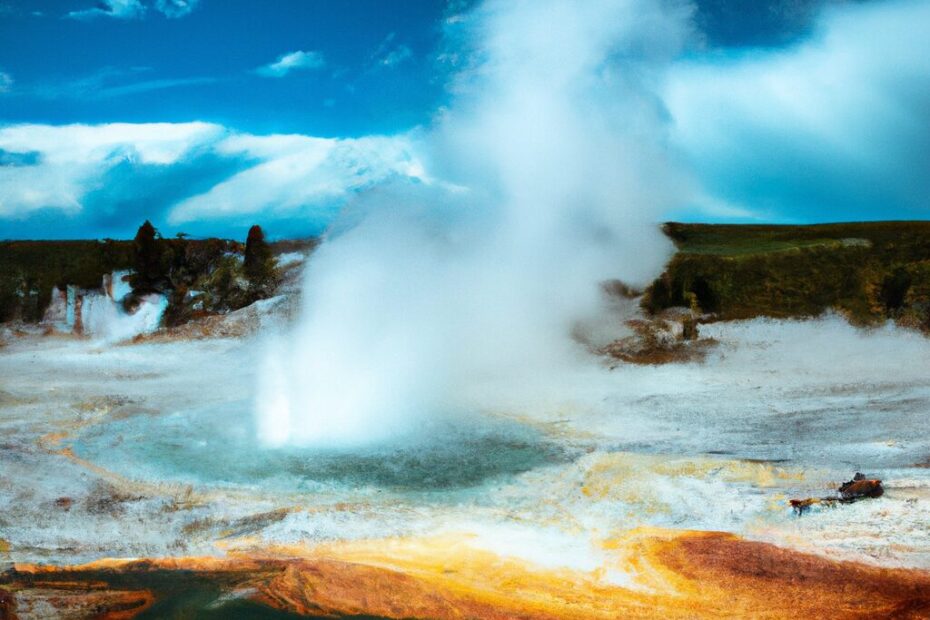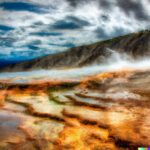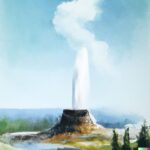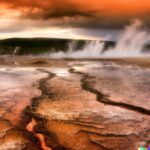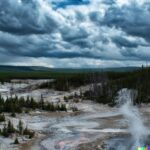Lower Geyser Basin, located in Yellowstone National Park, is a geothermal wonderland that boasts the largest collection of geysers in the world. From the bubbling Fountain Paint Pot to the explosive Great Fountain Geyser, this area is home to a wide variety of thermal features that are easily accessible to visitors.
With a rich history of Native American use and early exploration by European settlers, Lower Geyser Basin offers a unique blend of natural beauty and cultural significance. Whether you’re hiking along the scenic trails, picnicking among the geysers, or learning from ranger-led programs, there is something for everyone to enjoy in this fascinating destination.
What is Lower Geyser Basin?
Lower Geyser Basin, located in Yellowstone National Park, is a geothermal area renowned for its unique hydrothermal features, including geysers, hot springs, and other geologic wonders.
These hydrothermal features result from the active volcanic processes beneath the surface of the Earth, creating a mesmerizing landscape that showcases the power and beauty of nature’s forces.
As visitors explore the boardwalks winding through the basin, they are immersed in the sights and sounds of bubbling mud pots, colorful bacterial mats, and steam rising from various vents.
The dynamic nature of the geysers, such as Fountain Paint Pots and Great Fountain Geyser, offers a captivating display of water and steam eruptions that demonstrate the volatile energy hidden below the Earth’s crust.
Where is Lower Geyser Basin located?
Lower Geyser Basin is situated within the boundaries of Yellowstone National Park, specifically in the state of Wyoming, USA.
This geothermal area, located in the southwestern part of the park, boasts a diverse range of hydrothermal features such as geysers, hot springs, mud pots, and fumaroles. Lower Geyser Basin is known for its colorful, bubbling pools and mesmerizing thermal activity, attracting visitors from around the world to witness nature’s unique display. The basin’s proximity to notable attractions like Old Faithful and the Grand Prismatic Spring makes it a must-visit destination for those exploring the wonders of Yellowstone National Park in Wyoming.
What are the Main Features of Lower Geyser Basin?
Lower Geyser Basin boasts a diverse array of geysers, hot springs, and other hydrothermal features, with notable attractions such as the Great Fountain Geyser and Biscuit Basin captivating visitors.
The Great Fountain Geyser is particularly mesmerizing, with its soaring eruptions that can reach impressive heights. Visitors are often astonished by the powerful display of nature’s forces at this iconic geyser.
Biscuit Basin, on the other hand, offers a more serene experience, with its colorful hot springs dotting the landscape like pieces of art. The bubbling pools and vibrant hues create a surreal atmosphere that feels like stepping into a different world.
Exploring these unique features in Lower Geyser Basin provides an unforgettable glimpse into the dynamic geothermal activity that shapes Yellowstone National Park.
Fountain Paint Pot
Fountain Paint Pot in Lower Geyser Basin is a spectacle of bubbling mud pots, vivid colors, and unique geothermal features, including intricate bacteria mats.
The bubbling mud pots at Fountain Paint Pot create a mesmerizing display, constantly churning and emitting steam into the air. The vivid colors come from mineral deposits in the water, painting the landscape in hues of reds, yellows, and oranges. Alongside these colorful displays, the intricate bacteria mats add a fascinating contrast to the scene, showcasing the resilience and adaptability of life in extreme conditions. Visitors are captivated by the dynamic interaction of these elements, offering a glimpse into the raw power and beauty of nature’s processes.
Great Fountain Geyser
The Great Fountain Geyser stands as a prominent attraction in Lower Geyser Basin, known for its majestic eruptions, unpredictable schedule, and captivating display of geothermal dynamics.
Visitors to the area often find themselves drawn to the geyser’s unpredictable nature, as its eruption patterns can vary from a low bubbling simmer to a powerful jet of steaming water shooting up to heights of 75 feet. This variability creates an air of anticipation, with spectators eagerly awaiting the next display of natural beauty.
The geyser’s dynamic nature is a testament to the raw power and unpredictability of geothermal activity, reminding us of the forces that lie beneath the Earth’s surface.
White Dome Geyser
White Dome Geyser, one of the geysers in Lower Geyser Basin, showcases the geological marvels of Yellowstone, reflecting the region’s volcanic history and ongoing geothermal activity.
Being one of the most predictable geysers in the park, White Dome Geyser captivates visitors with its frequent eruptions, often reaching heights of around 30 feet. Its unique cone-shaped formation and the surrounding colorful bacterial mats add to its allure. This geyser, like many others in Yellowstone, owes its existence to the underlying magma chambers and hydrothermal reservoirs that create the ideal conditions for geysers to form and erupt. The hydrothermal features in Yellowstone, such as White Dome Geyser, serve as visible reminders of the supervolcano that lies beneath the park’s surface, continuing to shape and transform the landscape.
Red Spouter
The Red Spouter in Lower Geyser Basin is a fascinating thermal feature that exemplifies the intricate hydrothermal chemistry and geothermal manifestations present in the area.
Its striking crimson hue, caused by microbial mats, contrasts vividly with the surrounding landscape. This geothermal wonder continuously spouts boiling water and steam, showcasing the powerful forces beneath the Earth’s surface. The unique mix of gases like carbon dioxide and hydrogen sulfide creates an otherworldly ambiance around the Red Spouter. These hydrothermal activities result from heated water interacting with minerals deep underground, generating an impressive display that highlights the dynamic and ever-changing nature of geothermal features.
Spasm Geyser
Spasm Geyser within Lower Geyser Basin is a testament to the thermal dynamics fueled by underground subsurface plumbing and the interplay of thermal groundwater visible through its eruptions.
It’s fascinating how Spasm Geyser’s eruptions provide a glimpse into the intricate web of geological processes that shape its behavior. The geyser’s eruptions are not merely random events but are the result of a complex interplay between the superheated water from deep beneath the Earth’s surface and the pressure building up within its subsurface plumbing system. This dynamic interaction of heat, water, and geological structures manifests in the powerful bursts of steam and water that shoot up from the geyser, creating a spectacle that captivates visitors and scientists alike.
Leather Pool
The Leather Pool in Lower Geyser Basin is a captivating thermal pool teeming with microbial life, vivid colors, and the distinctive aroma of hydrogen sulfide permeating the air.
As you gaze upon the shimmering surface of the Leather Pool, you can witness a fascinating array of microorganisms thriving in the extreme conditions created by the presence of hydrogen sulfide. This unique combination of thermal waters and sulfur-rich compounds offers a haven for diverse forms of aquatic life, from thermophiles to cyanobacteria.
The varying temperatures within the pool contribute to the vibrant hues that paint its surroundings, making it a visual spectacle that showcases the raw beauty of nature’s intricacies.
What Makes Lower Geyser Basin Unique?
Lower Geyser Basin stands out for its unparalleled collection of geysers, hot springs, and diverse geothermal features, making it a unique hydrothermal basin that showcases nature’s wonders.
Its landscape is adorned with bubbling pools, colorful silica-rich terraces, and a variety of geothermal attractions, creating a surreal and mesmerizing environment. Visitors to the area are greeted by the sight of steam rising from the Earth and the smell of sulfur lingering in the air, adding to the otherworldly charm of the basin. The juxtaposition of vibrant blues, oranges, and greens against the backdrop of the rugged terrain makes Lower Geyser Basin a photographer’s paradise and a nature lover’s dream destination.
Largest collection of geysers in the world
Lower Geyser Basin boasts the largest collection of geysers globally, a testament to Yellowstone’s unique geology and the dynamic interplay of geothermal forces in the region.
The incredible concentration of geysers in Lower Geyser Basin is a direct result of the underlying geological formations that characterize Yellowstone National Park. The diverse landscape of the park, with its volcanic origins and hydrothermal features, creates the perfect conditions for geysers to form and thrive. The continuous interaction between the hot subsurface water and the cooler surface water gives rise to the spectacular eruptions that visitors marvel at each day. This natural phenomenon highlights the exceptional nature of the Lower Geyser Basin, drawing in scientists, nature enthusiasts, and curious explorers from around the world.
Wide variety of thermal features
Lower Geyser Basin offers visitors a wide variety of thermal features, including thermal pools, geothermal springs, and other hydrothermal marvels that showcase the area’s unique geologic landscape.
These thermal features are a result of the underground volcanic activity that shapes this fascinating region. The thermal pools, with their shimmering and colorful waters, create a captivating sight that is both beautiful and mysterious. Geothermal springs, known for their high temperatures and mineral-rich attributes, are a testament to the powerful forces at work beneath the earth’s surface. As visitors traverse the basin, they are greeted with a symphony of bubbling mud pots, steam vents, and fumaroles, each adding to the mesmerizing display of geologic diversity that defines Lower Geyser Basin.
Easy accessibility for visitors
Lower Geyser Basin offers easy accessibility for visitors, serving as a popular tourist destination and recreational area with ample visitor information and resources available.
Its proximity to the quaint town of West Yellowstone makes it a convenient stop for travelers exploring the wonders of Yellowstone National Park. The basin’s vibrant geothermal features, including bubbling mud pots and colorful hot springs, provide a captivating natural spectacle. Guided tours and informational signs throughout the area enhance the visitor experience by explaining the geological formations and cultural significance of the basin.
Whether you’re an outdoor enthusiast, a nature lover, or a curious wanderer, Lower Geyser Basin has something to offer every visitor seeking a memorable adventure in nature.
What is the History of Lower Geyser Basin?
The history of Lower Geyser Basin is rich and varied, with its lands having been utilized by Native Americans, explored by European settlers, and eventually developed into a fascinating tourist attraction showcasing earth’s geologic processes.
These geothermal features have held significance for Native American communities for centuries, with legends and spiritual beliefs intertwined with the bubbling hot springs and colorful pools. When European settlers stumbled upon the area in the 19th century, they were captivated by the otherworldly landscapes and started to document their discoveries. This led to an increased interest from scientists and tourists, culminating in the establishment of designated paths and boardwalks to allow visitors to marvel at the natural wonders while preserving the delicate ecosystem.
Native American use of the area
Native American tribes historically utilized the land within Lower Geyser Basin, recognizing its importance as part of the region’s ecosystem and the presence of unique hydrothermal features.
Their deep connection to the land stemmed from their understanding of how the various geothermal features, such as hot springs and geysers, played a vital role in their daily lives and spiritual practices. These tribes revered the natural springs for their healing properties and viewed the erupting geysers as powerful manifestations of the Earth’s energy. This symbiotic relationship between the Native American communities and the hydrothermal landscape highlights the profound respect they held for the environment.
Early exploration by European settlers
European settlers embarked on early explorations of Lower Geyser Basin, marveling at its geological formations, harnessing geothermal energy, and contributing to the area’s historical narrative.
Fascinated by the bubbling geysers, colorful hot springs, and steaming fumaroles, these settlers documented their findings, paving the way for further scientific research. By tapping into the natural heat reservoirs, they not only brought innovation to their communities but also laid the groundwork for modern geothermal energy utilization in the region. Their efforts not only shaped the landscape but also enriched the historical fabric of Lower Geyser Basin, leaving a lasting legacy for future generations to behold.
Development of tourist attractions
Over time, Lower Geyser Basin transformed into a hub of tourist attractions, catering to outdoor adventure seekers while maintaining a commitment to environmental preservation and showcasing the area’s natural beauty.
Visitors are drawn to the diverse array of outdoor activities available in Lower Geyser Basin, such as hiking along scenic trails, bird watching in the lush forests, and kayaking on crystal-clear waters. The region’s emphasis on sustainable tourism practices has led to the implementation of eco-friendly initiatives, including recycling programs, energy-efficient accommodations, and educational campaigns. Efforts to protect the unique flora and fauna in the area have resulted in the establishment of wildlife sanctuaries and conservation projects, further enhancing the natural allure of Lower Geyser Basin.
What Activities Can Visitors Do in Lower Geyser Basin?
Visitors to Lower Geyser Basin can engage in a myriad of activities, including hiking and walking trails, wildlife viewing, participation in ranger-led programs, and opportunities for recreational adventures amidst the geothermal wonders.
The hiking trails in Lower Geyser Basin offer enchanting paths through unique thermal features and lush forests, providing a scenic experience for outdoor enthusiasts. Wildlife viewing opportunities abound, allowing visitors to observe diverse species such as bison, elk, and birds in their natural habitat. Ranger-led programs offer educational insights into the geology and history of the area, enhancing the overall experience.
For those seeking recreational activities, options like fishing, picnicking, and photography create memorable moments in this breathtaking landscape.
Hiking and walking trails
Exploring the hiking and walking trails in Lower Geyser Basin offers visitors a chance to immerse themselves in outdoor adventure, witness geological diversity, and experience the natural wonders of the region.
As you traverse through these trails, the landscape transitions from lush forests to colorful meadows and bubbling hot springs, providing a feast for the senses. The paths wind through unique rock formations, revealing the area’s volcanic past and showcasing the power of nature. Be prepared to marvel at the variety of wildlife that call this area home, from soaring eagles to playful otters. Each step you take unveils a new vista, each turn in the trail leading to a breathtaking sight waiting to be discovered.
Picnicking and camping
Picnicking and camping in Lower Geyser Basin provide visitors with opportunities to enjoy the natural surroundings, follow designated guidelines, and make use of available visitor information for a memorable outdoor experience.
Whether you prefer a leisurely picnic amidst the geothermal wonders or a night under the stars at a designated campsite, Lower Geyser Basin offers a variety of options to connect with nature. By adhering to the camping guidelines set forth by the park authorities, visitors can ensure the preservation of the delicate ecosystem while enjoying the serene beauty of the surroundings. Utilizing the visitor information resources available allows for a smoother and more informed experience, enhancing your stay in this breathtaking natural setting.
Wildlife viewing
Wildlife viewing in Lower Geyser Basin offers visitors a chance to observe diverse aquatic life, protected species, and the natural beauty of the area within a designated and protected environment.
The waters of the basin are teeming with colorful fish, amphibians, and waterfowl, providing a rich and immersive experience for nature enthusiasts. One can catch glimpses of the elusive otters playing in the streams, while the skies above showcase majestic birds like bald eagles and ospreys. The meadows surrounding the basin bloom with vibrant wildflowers, enhancing the picturesque backdrop for observing the diverse wildlife. Protected species such as the endangered cutthroat trout thrive in these waters, underscoring the importance of conservation efforts in preserving this unique ecosystem.
Ranger-led programs and educational talks
Participation in ranger-led programs and educational talks in Lower Geyser Basin provides visitors with insights into the area’s hydrothermal features, opportunities for geothermal exploration, and a deeper understanding of the region’s geologic wonders.
These programs delve into the fascinating world of geothermal activity, offering a window into the natural processes that shape this unique landscape. Visitors can learn about the formation of geysers, hot springs, and fumaroles, gaining a newfound appreciation for the power of the Earth’s internal forces.
The educational talks often highlight the importance of environmental conservation and sustainable tourism practices in preserving these fragile ecosystems. With knowledgeable guides leading the way, participants are not only entertained but also educated on the significance of geology and geothermal energy in the Lower Geyser Basin.
Last Updated on February 11, 2024 by Jon Waraas – Originally Posted: February 11, 2024

I’m Jon Waraas, and I’ve been navigating the online world since 2006. By day, I’m the proud owner of some eCommerce gems, and by night, I’m the voice behind the adventures on Waraas.Com.
My heart, however, belongs to the wild beauty of Yellowstone National Park. I’ve got a collection of websites dedicated to sharing the wonders of this natural masterpiece. Oh, and did I mention? I’m currently building my own cabin inside the ghost town of Gilmore, Idaho – a cabin with tales to tell!
When I’m not immersed in the digital realm, you’ll find me lacing up my boots for a good hike or setting up camp under the star-studded sky.
